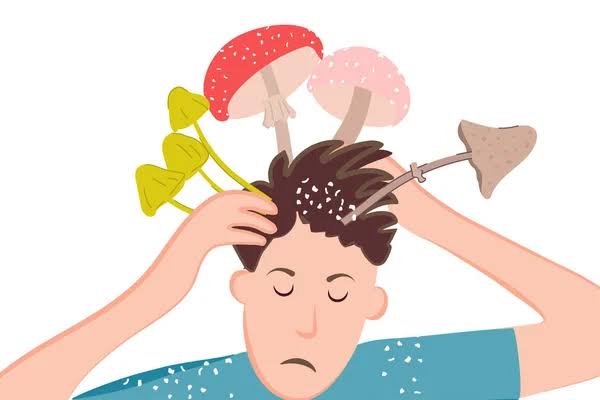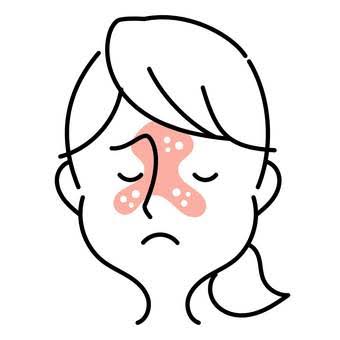A prevalent skin disorder that affects millions of individuals worldwide is seborrheic dermatitis. Seborrheic dermatitis, which is characterised by red, itchy, and flaky skin, can be uncomfortable and even unsightly at times. Although there are many different therapeutic options, homeopathy is one strategy that has drawn interest.
We will examine the pathogenesis, definition, signs and symptoms, investigations, general management, prevention, and risk factors of seborrheic dermatitis in this beginner’s guide. We will also discuss foods to avoid and foods to improve with regard to controlling this illness, as well as the possible advantages of homeopathic remedies.

Understanding Seborrheic Dermatitis
Chronic seborrheic dermatitis mainly affects the scalp, face, and chest, which are regions high in sebaceous (oil) glands. Redness, flakiness, and itching of the afflicted skin are common characteristics. The proliferation of a yeast known as Malassezia, an individual’s genetic makeup, and the general health of the skin are thought to combine to cause this disorder.
The Pathology of Seborrheic Dermatitis
Although the precise pathophysiology of seborrheic dermatitis is unknown, a number of elements are believed to be involved:
– Overgrowth of Malassezia: Malassezia is a type of yeast that typically resides on the skin. On the other hand, patients of seborrheic dermatitis have an overabundance of this yeast, which may cause the immune system to become inflamed.
– Genetics: Certain people may be more susceptible to seborrheic dermatitis due to genetic causes. You might be more vulnerable if there is a history of the illness in your family.
– Oil Production: Seborrheic dermatitis may be exacerbated by excessive oil production on the skin. That is why the scalp, face, and chest—areas with higher concentrations of sebaceous glands—are frequently affected by the illness.
– Immune Response: The inflammation and flakiness linked to seborrheic dermatitis may be made worse by the immune system’s reaction to the presence of malassezia and other causes.
The Causes of Seborrheic Dermatitis
Numerous causes might lead to the onset and aggravation of seborrheic dermatitis, even if its precise origin is still unknown. Typical reasons include:
– Malassezia Overgrowth: As previously indicated, an excessive proliferation of the yeast malassezia may play a noteworthy role.
– Hormonal Changes: Seborrheic dermatitis can be brought on by or made worse by hormonal fluctuations, which are frequently observed during adolescence, pregnancy, and in people with specific medical disorders.
– Stress: High levels of stress have been shown to aggravate a number of skin disorders, including seborrheic dermatitis.
– Cold and Dry Weather: During the winter, when the air is cold and dry, seborrheic dermatitis frequently flares up, causing greater dryness on the skin.
– Specific Medications: Certain medicines, such as those that impact neurological disorders or the immunological system, may make seborrheic dermatitis more likely.
The Risk Factors of Seborrheic Dermatitis
It is essential to comprehend the risk factors linked to seborrheic dermatitis in order to prevent and treat it. Typical risk variables consist of:
– Age: Although seborrheic dermatitis can affect newborns, adults, and the elderly, it is most frequent in the first three months of life and in those between the ages of 30 and 60.
– Family History: Your chance of getting seborrheic dermatitis may be increased if you have a family member who has the condition.
– Medical Conditions: A number of illnesses, including stroke, HIV/AIDS, and Parkinson’s disease, might raise the risk of seborrheic dermatitis.
– Neurological Conditions: Disorders affecting the neurological system, such as stroke and Parkinson’s disease, may make seborrheic dermatitis more likely.
The Signs and Symptoms of Seborrheic Dermatitis
Depending on the affected location and individual differences, seborrheic dermatitis can present with a variety of signs and symptoms. Typical signs and symptoms include of:
– Red or Inflamed Skin: Seborrheic dermatitis-affected areas may seem red and itchy.
– Flaky Skin: The illness frequently causes the skin to become covered in dry, white, or yellowish scales, which can be unsightly.
– Itchiness: Seborrheic dermatitis is frequently accompanied by mild to severe itching.
– Burning Sensation: Some people with seborrheic dermatitis describe feeling as though something is burning or stinging in the afflicted areas.
– Oily Skin: The skin may appear oily in regions where sebaceous glands are present.
– Dandruff: When seborrheic dermatitis affects the scalp, skin flakes may fall to the shoulders or onto clothes.
Investigations for Seborrheic Dermatitis
Healthcare practitioners may carry out certain tests in order to confirm the diagnosis and rule out other illnesses when treating seborrheic dermatitis. These inquiries may consist of:
– Physical Examination: The initial step in identifying seborrheic dermatitis is frequently a visual examination of the affected region. This entails looking for typical symptoms including redness and flakiness on the skin.
– Microscopic Examination: To determine whether malassezia is present, a skin sample may occasionally be removed and seen under a microscope.
– Biopsy: To rule out other disorders, a skin biopsy may be done in more severe or unusual cases.
– Patch Testing: To find probable allergens, patch testing may be done when an allergy is suspected.
– Blood Tests: These can assist in ruling out any underlying illnesses or imbalances that might be linked to seborrheic dermatitis.
General Management of Seborrheic Dermatitis
Self-care and prescription medications are used in the management of seborrheic dermatitis. The following are a few general management techniques:
– Cleaning: Excess oil and flakes can be removed with a gentle wash using soap and a light, fragrance-free shampoo. Wash your hair and the afflicted areas on a regular basis, but do not scrub too hard.
– Moisturizing: To lessen flakiness and relieve dryness, use a non-comedogenic moisturizer.
– Antifungal Shampoos: Scalp seborrheic dermatitis can be effectively treated with over-the-counter or prescription antifungal shampoos. Shampoos containing ketoconazole and selenium sulfide are popular options.
– Topical Steroids: To lessen inflammation in more extreme situations, a medical professional may recommend topical steroids.
– Topical Antifungals: For afflicted skin areas, topical antifungal lotions or ointments may be advised.
– Light Therapy: Phototherapy or light therapy can be used to treat symptoms in circumstances where treatment is refractory.
– Stress Management: You can avoid flare-ups by managing your stress with mindfulness, exercise, and relaxation techniques.
General Prevention of Seborrheic Dermatitis
It takes a combination of skincare routines and lifestyle changes to prevent or lessen seborrheic dermatitis. Here are a few precautions to take:
– Adequate Hygiene: To avoid the accumulation of oil and flakes, wash your face and hair on a regular basis using gentle, fragrance-free products.
– Stress Reduction: It can be helpful to manage stress through breathing exercises, physical activity, and stress-reduction tactics.
– Nutritional Decisions: To support general skin health, keep a balanced diet full of vitamins, minerals, and other nutrients.
– Preventing Triggers: Recognize and steer clear of individual triggers, such as allergies or particular skincare products.
– Limiting Alcohol: It is advisable to restrict your alcohol intake as it can cause seborrheic dermatitis.
Seborrheic Dermatitis: Foods to Improve and Avoid
Although there is not a single diet that can treat seborrheic dermatitis, eating habits can contribute to the illness’s worsening or improvement. Here are some items to think about incorporating into your diet and some to stay away from:
Foods to Improve Seborrheic Dermatitis:
1. Fatty Fish: High in omega-3 fatty acids, which have anti-inflammatory qualities and may help lessen skin irritation, are salmon, mackerel, and sardines.
2. Probiotics: Foods high in probiotics, such as kefir, kimchi, and yoghurt, can help maintain a healthy digestive system and possibly even improve the condition of the skin.
3. Fruits and Veggies: Consuming a lot of fruits and veggies helps to maintain healthy skin by supplying vital vitamins and antioxidants. Berries, kale, and spinach are very healthy.
4. Whole Grains: Because they have a lower glycemic index and can help balance blood sugar levels, whole grains like quinoa, brown rice, and oats may help reduce inflammation.
Foods to Avoid with Seborrheic Dermatitis:
1. Sugar: Consuming a lot of sugar-filled meals can aggravate skin disorders like seborrheic dermatitis and cause irritation.
2. Dairy: Some people may discover that consuming dairy exacerbates their symptoms. Try cutting back on or giving up dairy to see if it helps you.
3. Processed Foods: Trans fats and additives, which can cause inflammation and adverse effects on your skin, are frequently found in highly processed foods.
4. Gluten: Although sensitivity to gluten varies from person to person, some skin issue sufferers discover that cutting back on gluten in their diet helps alleviate their symptoms.
Homeopathic Remedies for Seborrheic Dermatitis
1. Graphites: Suggested for seborrheic dermatitis characterised by a fetid odour emanating from a humid, itchy eruption on the hairy scalp that is exacerbated by warmth and occurs during or after menstruation. Usually taken three times a day, with 3-5 pills, with potencies ranging from 6C to 30C.
2. Kali Sulphuricum: Used to treat seborrheic dermatitis, which is typified by a burning, itchy, papular eruption that gets worse at night and in warm environments. Take three to five pills, three times a day, in potencies ranging from 3C to 12C.
3. Natrum Muriaticum: Good for dry eruptions around the hairy scalp that are exacerbated by heat and warm environments, and that are relieved by taking a cold bath and being outside. It is usually taken as three to five pills three times a day, with potencies ranging from 12 to 200C.
4. Phosphorus: Used to treat dandruff, hair loss, and scalp irritation; frequently made worse by contact, temperature fluctuations, and being wet in hot weather. It is advised to take three to five pills, three times a day, at potencies ranging from 3C to 30C.
5. Thuja Occidentalis: Typically intensified at night and by the heat of the bed, this remedy is used for seborrheic dermatitis characterised by white, scaly dandruff and dry, falling hair. Available as a tincture or in a 30C potency; the suggested dosage is 5 drops three times a day or 10 drops in half a glass of water.

Conclusion: Heal your Skin!
To sum up, seborrheic dermatitis is a common skin disorder that has a variety of underlying reasons. Although there is not a single, effective treatment for this illness, managing your stress, adhering to a healthy diet, and practising good skincare habits can all help to prevent flare-ups and enhance the health of your skin.
In certain circumstances, homeopathic remedies might be viewed as an adjunct to conventional medical care. Speak with a medical expert if you think you may have seborrheic dermatitis so they can advise you on the best course of action for your situation. You can live a joyful and self-assured life despite this common skin issue if you take proper care of it.
Reach out to us for a Consultation.
This blog is for information purposes. It’s crucial to note that while homeopathy is a centuries-old practice with many adherents worldwide, always consult a qualified homeopath or medical professional before initiating any treatment.
For any queries, reach out to us at contact@homeopathic.ai





